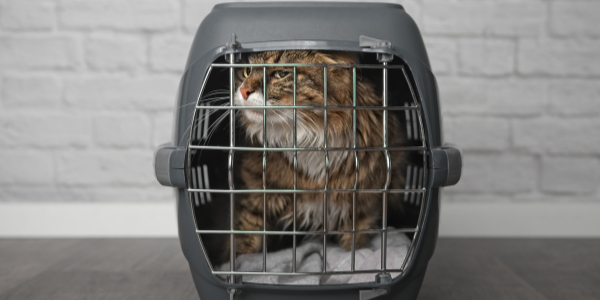
How to Make Cat Carriers Stress-Free
Often the only time cats get into a carrier is when they’re whisked off to the vet. It's not surprising they don't like it. Here's how to help your cat.

Our mission is to help save dogs' and cats’ lives through our educational content. To support our efforts, this page may contain affiliate links. We earn a commission for qualifying purchases – at no cost to you.
Choosing the right carrier for your cat’s comfort and safety, as well as one that fits your space and mobility limitations is easier than you think. Keep in mind, the carrier sets the tone for the upcoming experience, telling your cat whether they need to be fearful and put their guard up or relax knowing they’re secure.
If your cat feels safe and calm in the carrier, they’ll do better with the drive and feel less stressed at the vet or whatever your final destination may be. That’s why we’re looking at different styles, materials, frames, and more. We’ve got recommendations for a variety of cats, situations, and preferences.
Sleepypod takes pet travel safety very seriously. They do their own crash testing on their products (at the standard set for child safety restraints) and also received excellent marks in the Center for Pet Safety's crash testing studies. They're pricey but one of the few crash-test certified carriers available for cats.
The top comes off their Mobile Pet Bed completely so it can double as a pet bed when not used as a carrier. This feature actually helps cats feel more comfortable with their carrier as they use it on a daily basis.
The Amazon Basics two-door, top-load pet kennel is a hard-sided carrier that has easy open and close latches (rather than nuts and bolts) to secure top to bottom, as well as a top access door.
The Pet Gear carrier below, with its metal booster frame, can be secured with the car's seatbelt. The carrier also has an internal tethering system to attach to a harness.
If you want to use your carrier for flying, make sure the size of your hard carrier fits within your airline's under-seat regulations. Hard carriers aren't as "flexible" as soft-sided carriers when going under the seat. The carriers below claim they are appropriate for in-cabin use, but it's best to double-check the measurements with your airline.
Like all of Sleepypod's carriers, these two are crash-test certified for car travel.
The Sleepypod Mimi Mobile Pet Bed will fit in the cabin under your seat but only holds pets up to 7 lbs.
The Sherpa carrier is another good choice with a long track record of being an excellent and versatile cat carrier, both in the car and when flying.
The Siivton expandable carrier, featured in the section below, is also airline-approved.
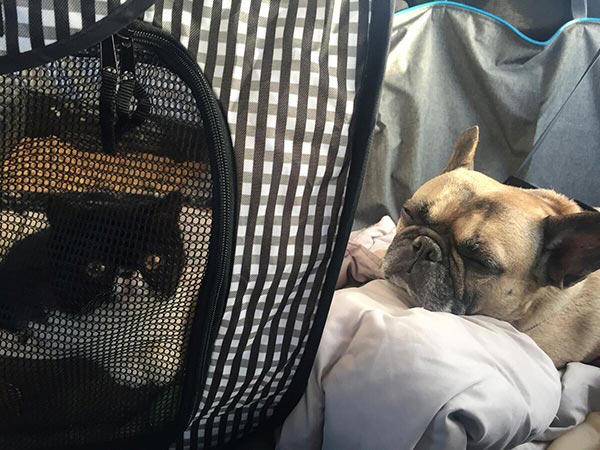 Preventive Vet team members Mazel and Marshall when they were on a cross-country road trip.
Preventive Vet team members Mazel and Marshall when they were on a cross-country road trip.
Mazel adapted to his carrier and integrated litter box right away. The carrier is featured below.
If your cat is going to be in the car for more than a few hours, you may want to use a larger carrier or kennel. This gives them room to stretch and move. You may be able to incorporate a small hiding spot, food, a non-spill water bowl, and a small litter box.
There is a safety trade-off, though. Many of the mid-size options are soft-sided, and you may not be able to buckle them in, or the seatbelt may smash the soft sides. They’re not designed to withstand an impact or sudden stop.
If you have room, consider a crash-tested dog kennel that can be anchored or is large enough that it won’t move around as much during an accident or sudden stop.
The Necoichi portable cat cage is more of a playpen/kennel style. It is soft-sided but has straps for securing it in the car, and it can fit a litter box, which is sold separately. Featured in the photo above – Preventive Vet’s Mazel enjoying his Necoichi hangout on a long road trip.
The Siivton 4-sided carrier has expandable sides, making this soft-sided carrier a little more spacious for your kitty than a traditional carrier. It doesn't really have enough room for you to include a litter box for your kitty within the carrier, so something to consider.
But many cats will choose to hold it until you settle into your overnight accommodations. They may not feel safe or stable enough to use the box in the car. Read more about this in the travel litter box section below.
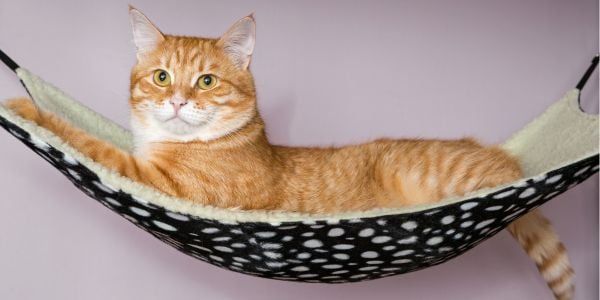
If you’ve got a lot more room in your car or SUV and really want to do right by your kitty, you can turn a large dog crate (like either of these: wire dog crate or plastic dog crate) into a kitty condo by including a soft mat, hammock, several of their toys, a nice hiding spot, and a small litter box.
Jumping right down to “business,” … depending on the duration of your travel adventures with kitty and where you’re winding up, you’re going to have to deal with litter box accommodations. This is the case both when you’re on the road and when you get to your hotel or destination.
Just because you give your cat access to a box doesn’t mean they’ll use it, especially if they’re nervous.
If they’re willing, you can help your cat take care of business on the road in a few different ways.
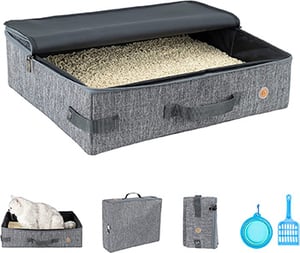
First, get them a good travel litter box. You’ll use the same litter they use at home and (perhaps) even a litter attractant. Set the travel box up in your home as an alternate option before your trip so your cat can get used to it.
Don’t replace your regular boxes with the travel box, though. Have both available.
A good travel litter box will be large enough for your cat to fit in and comfortably do their business in, yet small enough to fit in their carrier (see recommended larger car cat carriers above). It will also be waterproof and sturdy.
You can use a small plastic litter box or there are also disposable litter box options available. The travel litter box featured in the photo is handy with its zip-up feature and leak-proof design.
See our article on traveling with cats for more advice on using a litter box on the road and other helpful travel tips.
Before ever putting your cat into their carrier, be sure to spend the time acclimating them to it. See this article for a step-by-step guide on making your cat comfortable with their carrier.
Avoid feeding your cat a full meal within 2 hours of travel. This helps, especially if your cat suffers from carsickness and vomiting.
Spray your cat’s carrier or the blanket/towel inside with calming pheromones about 30 to 60 minutes BEFORE putting them into it.
Give your cat a calming treat about 60 minutes before placing them in the carrier.
Be sure to warm or cool your car before putting your cat in it.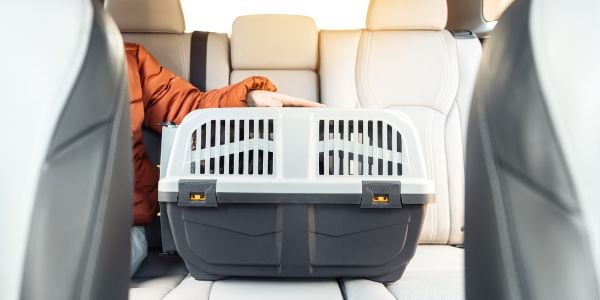
Place and secure the carrier in the middle of the back seat. This protects it from airbags if your car has them in the back and provides better protection in case of a side-impact accident. If you can't secure it, then putting the carrier on the floor behind a seat might be more secure.
Keep the car ride quiet and calm. Avoid playing loud music. Cats can be soothed by playing classical music.
If going on an extended trip, stop every 2 to 3 hours to give your cat a chance to drink water and use a litter box. Get more tips for long-distance travel.
Don’t forget to pack cleaning items in case of any soiling accidents.
You may think your cat’s carrier isn’t that important, especially when you’re taking short trips or going to the vet. After all, it’s just a quick car ride. But that couldn’t be further from the truth.
The carrier type can impact your cat's safety and comfort level. Not to mention that short trips essentially condition your cat for longer trips. If short trips are low-stress and comfortable, your cat will do better with long trips.
It can be helpful to have two different sizes — a smaller option that you can more easily carry and a larger option if your cat will be spending extended periods in it. If you have the space, both in the car and storage at home and don’t mind carrying the added weight, you can opt for a single larger travel carrier (see above).
For extremely fearful cats, the Feline Veterinary Medical Association recommends hard-sided carriers. They offer added safety for you and your cat. And the stability of the hard sides makes them easier to stabilize and carry.
It’s also important to help your cat reduce their fear of the carrier. We have an article all about that!
You may think your cat’s carrier isn’t that important, especially when you’re taking short trips or going to the vet. After all, it’s just a quick car ride. But that couldn’t be further from the truth.
The carrier type can impact your cat's safety and comfort level. Not to mention that short trips essentially condition your cat for longer trips. If short trips are low-stress and comfortable, your cat will do better with long trips.
It can be helpful to have two different sizes — a smaller option that you can more easily carry and a larger option if your cat will be spending extended periods in it. If you have the space, both in the car and storage at home and don’t mind carrying the added weight, you can opt for a single larger travel carrier (see above).
For extremely fearful cats, the Feline Veterinary Medical Association recommends hard-sided carriers. They offer added safety for you and your cat. And the stability of the hard sides makes them easier to stabilize and carry.
It’s also important to help your cat reduce their fear of the carrier. We have an article all about that!

Often the only time cats get into a carrier is when they’re whisked off to the vet. It's not surprising they don't like it. Here's how to help your cat.
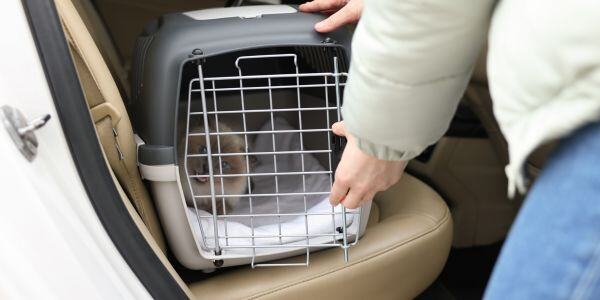
There are things you can do to help your cat with car anxiety and carsickness. Explore the options that may help your cat with their stress and nausea.
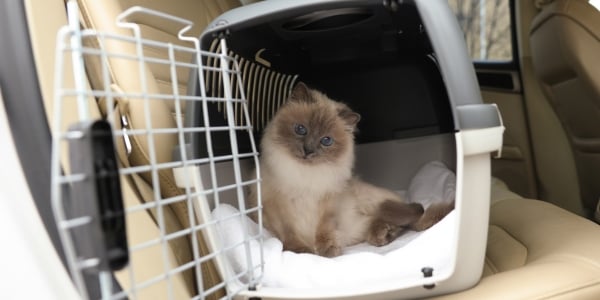
Find out how to long-distance travel with your cat in a car. Practical tips and trainer and vet-approved solutions to make your trip as smooth as possible.

Diarrhea is one of the most common problems for cats. At-home treatments can help, but even a mild case can become serious if not treated properly.
